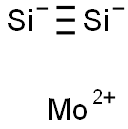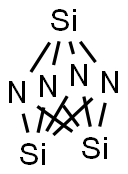Molybdenum silicide
Synonym(s):Molybdenum silicide
- CAS NO.:12136-78-6
- Empirical Formula: MoSi2
- Molecular Weight: 152.11
- MDL number: MFCD00151535
- EINECS: 235-231-8
- SAFETY DATA SHEET (SDS)
- Update Date: 2024-12-18 14:08:52

What is Molybdenum silicide?
Chemical properties
Molybdenum silicide is dark-gray, crystalline powder. Not affected by air upto 1648°C. Not attacked by most inorganic acidsincluding aqua regia, but very soluble in hydrofluo-ric and nitric acids. Has high stress-rupture strength.
Physical properties
The compound is thermally stable in air up to 1000°C. Corrosion resistant to molten metals such as Zn, Pd, Ag, Bi, and Rb. Corroded by liquid metals Mg, Al, Si, V, Cr, Mn, Fe, Ni, Cu, Mo, and Ce.
The Uses of Molybdenum silicide
In electrical resistors, in protective coatings at high temperatures, and in engine parts in space vehicles Molybdenum silicide is used in electric furnaces, glass, steel, electronics and ceramics industries. It finds application in heat treatment materials. It is also used in microelectronics as a contact material. Further, it serves as a dry lubricant.
The Uses of Molybdenum silicide
MOLYBDENUM SILICIDE can be considered as an electrically conducting ceramic with primary use in heating elements operating at temperatures above 1,500℃ in air. It is also considered as a material for very high temperature structural applications.
Definition
MOLYBDENUM SILICIDE is A cermet.
What are the applications of Application
Molybdenum disilicide (MoSi2) is a ceramic material with excellent high-temperature oxidation resistance and corrosion resistance. It can be used as a substrate material in the fabrication of thermophotovoltaics. MoSi2 can also be used as a protective coating on carbon-carbon composites for potential applications in aerospace and thermonuclear fusion.
Preparation
Molybdenum disilicide is a promising candidate material for high temperature structural applications. Molybdenum silicide is produced in much the same way as ferromolybdenum. A typical mix for the production of molybdenum silicide is 1,000pounds of molybdenum in oxide, 259 pounds of aluminum, 760 pounds of 90-percent ferrosilicon, 166 pounds of 50-percent ferro-silicon, 160 pounds of lime, and 50 pounds of high-grade fluorspar.
General Description
This product has been enhanced for energy efficiency.
Hazard
MOLYBDENUM SILICIDE is Toxic material.
Flammability and Explosibility
Not classified
Industrial uses
High-temperature silicides are a new class of materials with potential applications in the temperature range 1200 to 1600 C.The silicide that seems most promising is molybdenum disilicide (MoSi2) because of its high melting temperature (2200 C) and excellent oxidation resistance. It has a tetragonal crystal structure. A major problem is its absence of ductility at temperatures up to 1000 C. It also has poor high-temperature strength due to the presence of a grain boundary silicon-rich phase that may become viscous at very high temperatures. Recent research has shown that this problem may be solved by the addition of carbon to the material.
Properties of Molybdenum silicide
| Melting point: | 1930°C |
| Density | 6.31 g/mL at 25 °C(lit.) |
| solubility | insoluble in H2O; soluble in HF |
| form | powder |
| color | Dark gray |
| Specific Gravity | 6.31 |
| Resistivity | 21.5 (ρ/μΩ.cm) |
| Water Solubility | Insoluble in acids and aqua regia, however, it is soluble in HF and HNO{3}Soluble in nitric acid and hydrofluoric acid. Insoluble in water most acids. |
| Crystal Structure | Tetragonal |
| Exposure limits | ACGIH: TWA 10 mg/m3; TWA 3 mg/m3 NIOSH: IDLH 5000 mg/m3 |
| EPA Substance Registry System | Molybdenum silicide (MoSi2) (12136-78-6) |
Safety information for Molybdenum silicide
Computed Descriptors for Molybdenum silicide
New Products
(S)-3-Aminobutanenitrile hydrochloride 4-Methylphenylacetic acid N-Boc-D-alaninol N-BOC-D/L-ALANINOL Tert-butyl bis(2-chloroethyl)carbamate 3-Morpholino-1-(4-nitrophenyl)-5,6-dihydropyridin- 2(1H)-one Furan-2,5-Dicarboxylic Acid Tropic acid 1-Bromo-3,5-Di-Tert-Butylbenzene S-2-CHLORO PROPIONIC ACID ETHYL ISOCYANOACETATE 2-Bromo-1,3-Bis(Dimethylamino)Trimethinium Hexafluorophosphate 4-IODO BENZOIC ACID 3-NITRO-2-METHYL ANILINE 1-(2,4-DICHLOROPHENYL) ETHANAMINE (2-Hydroxyphenyl)acetonitrile 4-Bromopyrazole 2-(Cyanocyclohexyl)acetic acid 4-methoxy-3,5-dinitropyridine 1-(4-(aminomethyl)benzyl)urea hydrochloride 2-aminopropyl benzoate hydrochloride diethyl 2-(2-((tertbutoxycarbonyl)amino) ethyl)malonate tert-butyl 4- (ureidomethyl)benzylcarbamate Ethyl-2-chloro((4-methoxyphenyl)hydrazono)acetateRelated products of tetrahydrofuran








You may like
-
 Molybdenum silicide CAS 12136-78-6View Details
Molybdenum silicide CAS 12136-78-6View Details
12136-78-6 -
 Molybdenum silicide CAS 12136-78-6View Details
Molybdenum silicide CAS 12136-78-6View Details
12136-78-6 -
 Molybdenum disilicide, 40-60 μm CAS 12136-78-6View Details
Molybdenum disilicide, 40-60 μm CAS 12136-78-6View Details
12136-78-6 -
 Molybdenum disilicide, 99.8% CAS 12136-78-6View Details
Molybdenum disilicide, 99.8% CAS 12136-78-6View Details
12136-78-6 -
 Molybdenum disilicide, 10-45 μm CAS 12136-78-6View Details
Molybdenum disilicide, 10-45 μm CAS 12136-78-6View Details
12136-78-6 -
 Molybdenum disilicide CAS 12136-78-6View Details
Molybdenum disilicide CAS 12136-78-6View Details
12136-78-6 -
 14714-50-2 (2-Hydroxyphenyl)acetonitrile 98+View Details
14714-50-2 (2-Hydroxyphenyl)acetonitrile 98+View Details
14714-50-2 -
 118753-70-1 98+View Details
118753-70-1 98+View Details
118753-70-1